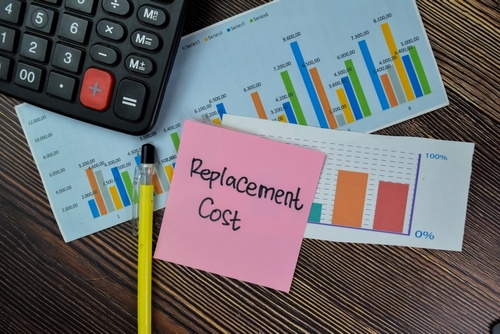

When it comes to businesses looking to mitigate risk, one concept that’s important to explore is reproduction costs. The first step is to distinguish between reproduction and replacement costs. Replacement cost refers to how much it would cost a company to replace an asset that will duplicate the performance of the beginning asset; however, it does not necessarily have to meet the same materials, specifications, etc. Reproduction cost refers to how much it would cost a company to reproduce the asset so that it’s constructed of the same materials, specifications, etc., based on current market prices.
When looking to assess real estate accurately, the cost approach examines how much a builder would need to spend on the land and building outlays to replicate the original building and its functionality. This looks at what the current market conditions would assess the land for and the construction/development costs on said land. From there, it removes depreciation to obtain its property value.
It’s expressed as follows:
Property Value = Replacement / Reproduction Cost – Depreciation + Land Value
The first step is to determine the structure’s reproduction and replacement costs. The Replacement Method looks at expenses that would be incurred to build a structure featuring the same usefulness as the building under review, constructed with present-day raw materials, blueprints, specifications, etc. The Reproduction Method looks at how much it would cost to build an exact replica of the original structure, employing analogous inputs and building standards. It also requires adhering to historically accurate conventions and blueprints. Naturally, when comparing a historic property to a recent building, there would be a greater divergence between replacement and reproduction costs.
Depreciation of improvements for the next step must be estimated. This is defined as the difference between the value of renovations and the current contributing value of them, which is measured in three ways:
After calculating the three conditions in the aforementioned questions, the resulting figure is the accrued depreciation. This step entails looking at current property values to ascertain a competitive worth for the land. This can be referred to as the Estimated Assessed Value of Land to give the value a name.
From there, the accrued depreciation must be taken off the value of either the replacement cost or reproduction cost. It’s expressed as follows:
Replacement Cost or Reproduction Cost (either can be selected depending on the desired outcome) – Accrued Depreciation
The resulting figure is referred to as the Depreciated Cost of the Structure.
Once the Accrued Depreciation is accounted for, the land’s estimated assessed value must be added to the Depreciated Cost of the Structure figure. It is calculated as follows:
Completed Estimate of Real Estate = Depreciated Cost of the Structure + Estimated Assessed Value of Land
Contemplating the Cost Approach’s Drawbacks
One concern is that if there’s a problem finding the right lot, the parcel’s valuation might not reflect its true worth. Zoning or land-use restrictions can reduce the attractiveness of a parcel of land, thereby lowering its value. When it comes to calculating depreciation for older properties, age could skew the value estimate. For example, with construction materials for certain items may not be available anymore, making the calculation subject to interpretation.
Understanding how different cost assessments work allows business owners to make decisions that benefit their customers and their bottom line.
These articles are intended to provide general resources for the tax and accounting needs of small businesses and individuals. Service2Client LLC is the author, but is not engaged in rendering specific legal, accounting, financial or professional advice. Service2Client LLC makes no representation that the recommendations of Service2Client LLC will achieve any result. The NSAD has not reviewed any of the Service2Client LLC content. Readers are encouraged to contact a professional regarding the topics in these articles. The images linked to these articles are protected by copyright and should not be copied for any reason.